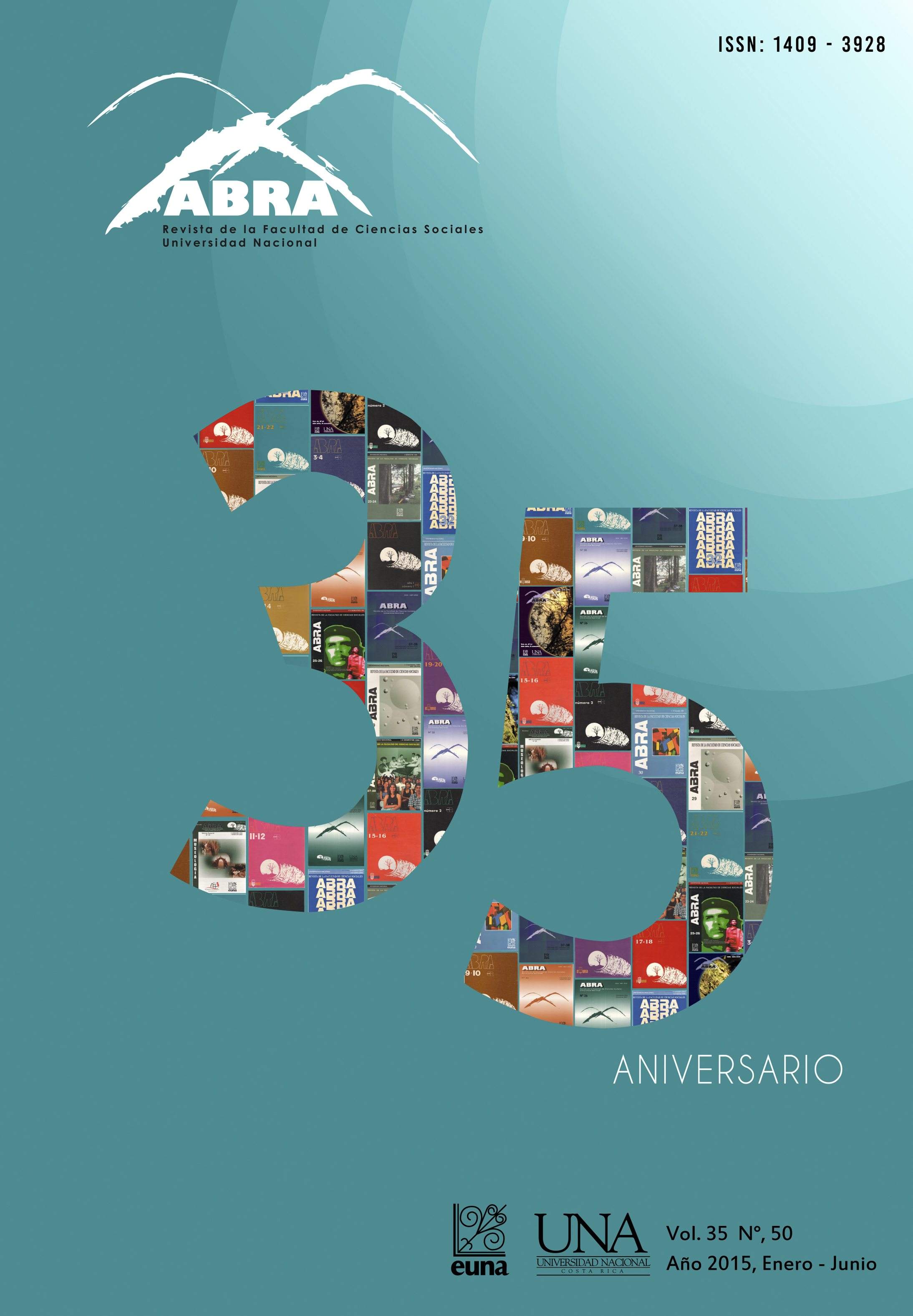Inclusive Museum: Look and don ́t touch
DOI:
https://doi.org/10.15359/abra.35-50.3Keywords:
social model of disability, Social inclusión, universal design, accesible cultural servicesAbstract
This paper is a brief conceptual and theoretical work about paradigmatic changes in disability, focused over the Social Model and the universal design and its effects in human rights of accessing into culture and practical actions that can be adopted to turn accessible to all te people, mainly elderly citizen (65 year old and elder) cultural services and spaces, mostly, those from museums and art galleries
It is based on personal reflections and own experiences, and pretend to sensitize about the experience of people with sight disability trying to access to this services, besides, to offer some general recommendations and expose several questions about the role universities in widening the opportunities of accessing and enjoying all cultural products and services for people with disability and the elderly.
In order to avoid exclusion and discrimination because of the different barriers of the costarrican cultural world, public policies and legislation in the cultural rights field, it must be contemplated the designing of spaces, products and services applying universal design and the accessibility criteria for all people. In Costa Rica this is legally entailed for those programs and services that count with state and municipal financing.
References
Banco Mundial y Organización Mundial de la Salud (2011). Informe mundial sobre la discapacidad 2011. Recuperado de http://www.who.int/disabilities/world_report/2011/es/index.html
Barnes, C. (2012). Understanding the Social Model of Disability: Past, Present and Future. En Watson, N. Roulstone, A. and Thomas, C. (Eds.), The Routledge Handbook of Disability Studies. London: Routledge Taylor & Francis Group. Recuperado de http://www.routledge.com/books/details/9780415574006/
Bell, J., Matty, S. & Weisen, M. (2006). Museums, Libraries and Archives (MLA). Disability Survey 2005 (Summary). London. Recuperado de http://www.ne-mo.org/fileadmin/Dateien/public/topics/Disability_and_museums/disability_survey_2005_summary_10447.pdf
Center for Universal Design (2006). Definitions: accessible, adaptable and universal Design (Fact Sheet number 6). Recuperado de: http://www.ncsu.edu/ncsu/design/cud/pubs_p/docs/Fact%20Sheet%206.pdf
Cohen, J. (2004). Reglas de etiqueta frente a una persona con discapacidad: sugerencias para relacionarse con las personas con discapacidades. Estados Unidos: United Spinal Association ACCESS Resorces. Recuperado de http://www.upla.cl/inclusion/wp-content/uploads/2014/05/2014_0516_inclusion_discapacidad.pdf
Consejo Nacional de Rehabilitación y Educación Especial CNREE (2005). Dimensiones del entorno. (Documento de trabajo inédito).
Consuegra, B. (2002). Acceso al patrimonio histórico de las personas ciegas y deficientes visuales. España: Organización Nacional de Ciegos Españoles (ONCE), Dirección de Cultura y Deporte. Recuperado de http://www.once.es/serviciosSociales/index.cfm?navega=detalle&idobjeto=86&idtipo=1
Davis, K. (2000). A Social Barriers Model of Disability: Theory into Practice. The Emergence of the "Seven Needs". Paper prepared for the Derbyshire Coalition of Disabled People. Derbyshire, England.
Ferreira, M. y Díaz, E. (2007). La discapacidad: Una modalidad inexplorada de exclusión social. Ponencia para el III Congreso Nacional Discapacidad y Universidad. Zaragoza, España. Recuperado de http://www.um.es/discatif/TEORIA/FerreiraDiaz_Zaragoza.pdf
Hooper-Green-Hill, E., Sandell, R., Moussouri, T. & O’Riain, H. (2000). Museums and Social Inclusion, the GLLAM Report. Leicester, England: Department of Museum Studies, University of Leicester. Recuperado de http://www2.le.ac.uk/departments/museumstudies/rcmg/projects/small-museums-and-social-inclusion/GLLAM%20Interior.pdf
Instituto Nacional de Estadísticas y Censos (2012). X Censo Nacional de Población y VI de Vivienda 2011: Resultados generales. San José, Costa Rica. Recuperado de http://www.cipacdh.org/pdf/Resultados_Generales_Censo_2011.pdf
Joffee, J & Siller, M. (1997). Reaching out: Creative access guide for designing exhibits & cultural services for persons who are blind or visually impaired. AFB Press, 1997. videocassette and guidebook). Recuperado de http://www.afb.org/info/programs-and-services/professional-development/teachers/expanded-core-curriculum/ecc-resources/12345
Hunt, P. (1966). A critical condition, Stigma: The Experience of Disability. Recuperado de http://disability-studies.leeds.ac.uk/files/library/Hunt-critical-condition.pdf
Martín, C. y Muñoz, P. (2007). Discapacidad y Acceso a los Espacios Culturales. Más allá de las barreras arquitectónicas: La comunicación como Herramienta. Recuperado de http://www.mastergestioncultural.org/files/File/TESINAS/T07-0158%20Martn%20y%20Perugorria,%20Discapacidad%20y%20Acceso%20a%20la%20Cultura.pdf
Mata, N. (29 de febrero de 2008). Artistas lamentan cierre del MUFES. Recuperado de http://www.redcultura.com/php/Articulos4.htm
National Endowment for the Arts (2004). Accessibility planning and resource
Guide for Cultural Administrators. Estados Unidos: National Endowment for the Arts USA Government. Recuperado de http://arts.gov/accessibility/publications-checklists/accessibility-planning-and-resource-guide-cultural
Oliver, M. (1990). The Individual and Social Models of Disability. Paper presented at Joint Workshop of the Living Options Group and the Research Unit of the Royal College of Physicians. London. Recuperado de http://disability-studies.leeds.ac.uk/files/library/Oliver-in-soc-dis.pdf
Organización de las Naciones Unidas. (2006). Convención de los derechos de las personas con discapacidad. Recuperado de http://www.un.org/spanish/disabilities/default.asp?id=497
Organización Mundial de la Salud y Organización Panamericano de la Salud. (2001). Clasificación Internacional del Funcionamiento, de la Discapacidad y de la Salud: CIF (versión abreviada). México: CONADIS. Recuperado de http://www.conadis.salud.gob.mx/descargas/pdf/CIF_OMS_abreviada.pdf
Parra, C. y Palacios, M. (julio-diciembre, 2007). Enfoque de derechos humanos en la política pública de discapacidad. Universidad Sergio Arboleda, 7(13), 97-114, Recuperado de http://www.usergioarboleda.edu.co/civilizar/revista13/Enfoque%20de%20derechos%20humanos.pdf
Sen, A. (diciembre, 2004). Discapacidad y Justicia. Trabajo presentado en la Segunda Conferencia Internacional sobre Discapacidad y Desarrollo Inclusivo del Banco Mundial, Washington. Recuperado de http://pdi.cnotinfor.pt/recursos/A%20Sen-DISCAPACIDAD%20Y%20JUSTICIA.doc
The Union of the Physically Impaired Against Segregation and The Disability Alliance. (1976). Fundamental Principles of Disability. Recuperado de http://disability-studies.leeds.ac.uk/files/library/UPIAS-fundamental-principles.pdf
Downloads
Published
How to Cite
Issue
Section
License
This publication is under a Creative commons attribution NonCommercial-ShareAlike 4.0 International and all restrictions and attributions must be regarded.
Authors that publish in this journal agree to grant exclusive, costless, worldwide and timeless ownership of their rights over the paper to Universidad Nacional, Costa Rica.
Revista ABRA by Universidad Nacional is licensed under a Creative Commons Reconocimiento-NoComercial-CompartirIgual 4.0 Internacional License.
Creado a partir de la obra enhttp://www.revistas.una.ac.cr/index.php/abra.











